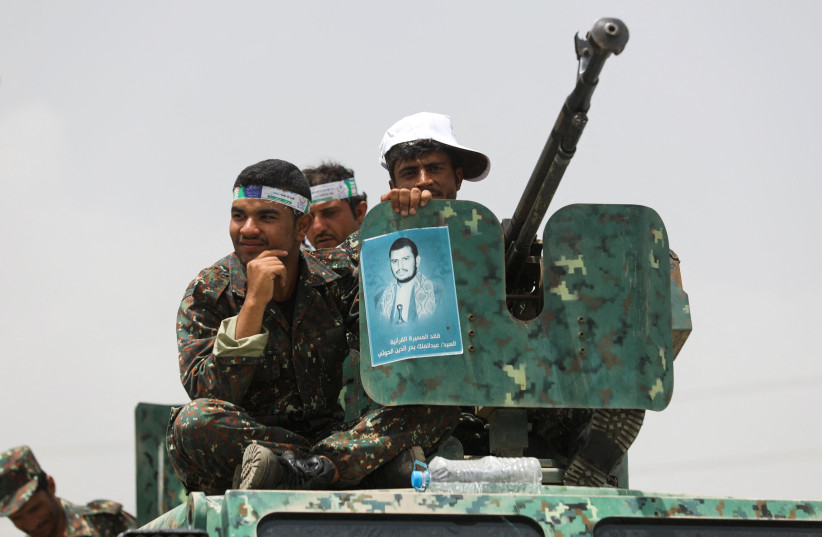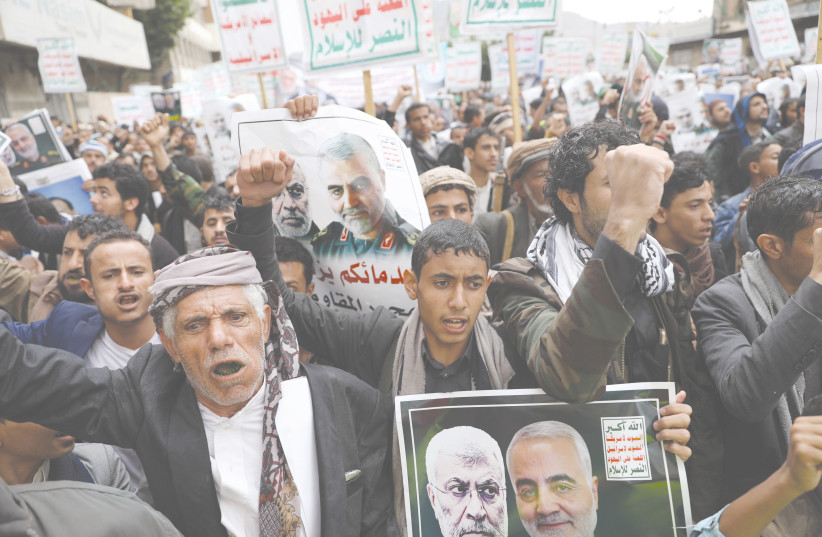Amid regional and international efforts and calls to sustain the humanitarian truce in Yemen, we Yemenis watch cautiously the time bomb that is about to explode as we see and hear the moves of the Iranian regime and its Houthi proxy toward military escalation, not toward de-escalation. That is the elephant in the room that the international community refuses to acknowledge.
Instead of being involved in promoting de-escalation efforts, sustaining the United Nations-sponsored truce five months after its collapse, implementing its provisions and moving to a comprehensive cease-fire, and starting negotiations for a final solution to the crisis, the Houthi militia continues to adopt the language of escalation on both the political and military fronts, with an unprecedented escalation of shipments of smuggled arms coming from Iran.
On January 15, the French Navy intercepted an Iranian ship carrying 3,000 rifles, 500,000 rounds of ammunition, and 20 anti-tank guided missiles on its way to the Houthi militia. Days after, the security services in the Shahn port in Yemen announced the seizure of 100 drone engines, which also were on their way to the Houthis.
Earlier in January 2023, the US Navy said it had seized more than 2,000 rifles destined for the Houthis, and on December 1, 2022, intercepted a fishing vessel smuggling more than 50 tons of ammunition, fuses, and rocket fuel, and seized 1,400 rifles and more than 226,000 rounds of ammunition from a ship coming from Iran, and confiscated more than 1.1 million rounds from a fishing boat operating between Iran and Yemen.


On November 8, 2022, the US Navy intercepted a fishing vessel carrying 70 tons of ammonium chlorate – an oxidizing agent used for rocket fuel, as well as 100 tons of urea fertilizer; and in July 2022, the United Kingdom said that the Royal Navy had confiscated surface-to-air missiles and cruise missile engines from a sailing boat off the southern coast of Iran.
According to the US Central Command’s statement, the volume of seizures off the coast of Yemen reached its highest level in 2022, with 9,000 weapons – an increase of 200% in the number of weapons seized in 2021.
In a statement issued a few days ago, US Navy 5th Fleet spokesman Commander Tim Hawkins confirmed that the US Navy and multinational forces seized over the past two months more than 5,000 weapons and 1.6 million rounds of ammunition.
The Iranian escalation in the smuggling of arms shipments is not isolated from the accelerated Houthi mobilization of resources, material, and human capabilities in preparation for what appears to be a new round of escalation. This includes the mid-2022 military parades organized by the Houthi militia despite the truce, and the mobilization of thousands of forcibly recruited civilians and children to the battlefronts, lured from the summer centers in areas under Houthi control.
Houthi mobilization during truce
This unjustified escalation and mobilization were accompanied by intransigence by the Houthi militia against confidence-building steps and the approaches it was supposed to take to implement the terms of the truce, including opening safe corridors for civilians and lifting the siege on Taiz Governorate, which has the largest population density in Yemen, as well as proceeding with negotiations for a comprehensive exchange of prisoners and abductees – including political and military leaders, media professionals and journalists.
The questions that should be raised are: Why Iran is sending this arsenal of weapons to Yemen? And why are the Houthis mobilizing weapons and fighters despite the calls for de-escalation? And how, and by whom, are these terrorist activities financed? And why not spend these billions of riyals to pay part of the salaries of public servants, whose work has been suspended since 2018, or the salaries of teachers who were suspended for a whole year? Or harnessing it to secure food for the millions of hungry people in the areas it controls?
These are questions that cannot be answered in isolation from reading the scene in the region. This includes the escalation of popular protests calling for the overthrow of the Iranian regime, as well as the faltering negotiations to revive the nuclear deal, and the Tehran regime waving its cards in the region to divert attention from the internal unrest while it attempts to pressure the international community so that it can reap additional gains at the negotiating table.
This was revealed in a statement by Qasem Homran, the commander of the so-called Support Brigades – a militia force created after the announcement of the truce in April 2022, during a military parade of graduates of the military workshop in Dhamar Governorate in central Yemen. In it, he confirmed that his militia is "an inseparable part of the Iranian axis,” at the same time as Hizbullah Secretary-General Hassan Nasrallah was threatening to start a new war in the region.
Those military parades – in which the Houthis reproduced the style and slogans of the sectarian militias established and run by the Iranian Revolutionary Guards, Lebanon’s Hizbullah, and the Iraqi Mobilization Forces, demonstrated the state of schizophrenia that this militia is experiencing between the calls and efforts to consolidate de-escalation and peace in Yemen, and its reality as a terrorist militia that has pledged itself to Iran and its destructive policies in the region. These parades also revealed the continued flow of Iranian weapons and military technologies through the ports of the city of Hodeidah, including rifles, sniper rifles, anti-tank missiles, and Rajum and Ababil drones; the smuggling routes of these weapons recently were revealed in a United Nations Panel of Experts report.
Therefore, it is not possible to think about peace in Yemen in isolation from dealing with what is happening in the region. The Iranian role in Yemen is adding to the conflict and hindering peace efforts. This is due to Iran's destabilizing policies for both Yemen and the region, as well as its threat to international interests, compared to the role played by the Saudi-led coalition of Arab countries in leading de-escalation and peace efforts which culminated in the declaration of a truce in April 2022. The coalition also supports the government in normalizing the situation in liberated areas, providing services, improving economic conditions, stabilizing the currency, and offering relief and humanitarian aid to millions of civilians.
Therefore, it is the responsibility of the international community, led by the permanent members of the Security Council, to review its handling of the Yemeni file if it is serious about ending the war there once and for all.


Any upcoming international agreement with Iran must include the status of its sectarian militias in the region, led by the Houthis, and require Iran to stop using these militias as a proxy to extend its influence and impose its expansionist project. The agreement also must exert real pressure on the Houthi militia to force it to stop its escalatory steps and review the pattern of its relationship with Iran, and push it to engage seriously and in good faith in de-escalation and move to a political path that ends the war and puts an end to the human tragedy that Yemenis are experiencing, while putting the interests of Yemen first.
As they continue their efforts to revive and expand the truce, the international community and the United Nations’ special envoy for Yemen must be aware that this truce will not be a step toward peace if the situation continues without oversight over the implementation of its provisions, and without accountability for its breaches. The insistence on ignoring the Iranian role in fueling the conflict and the exacerbation of the humanitarian catastrophe in Yemen is a non-strategic behavior that will bring us back to square zero, with the loss of a lot of time, capabilities, and innocent lives.
